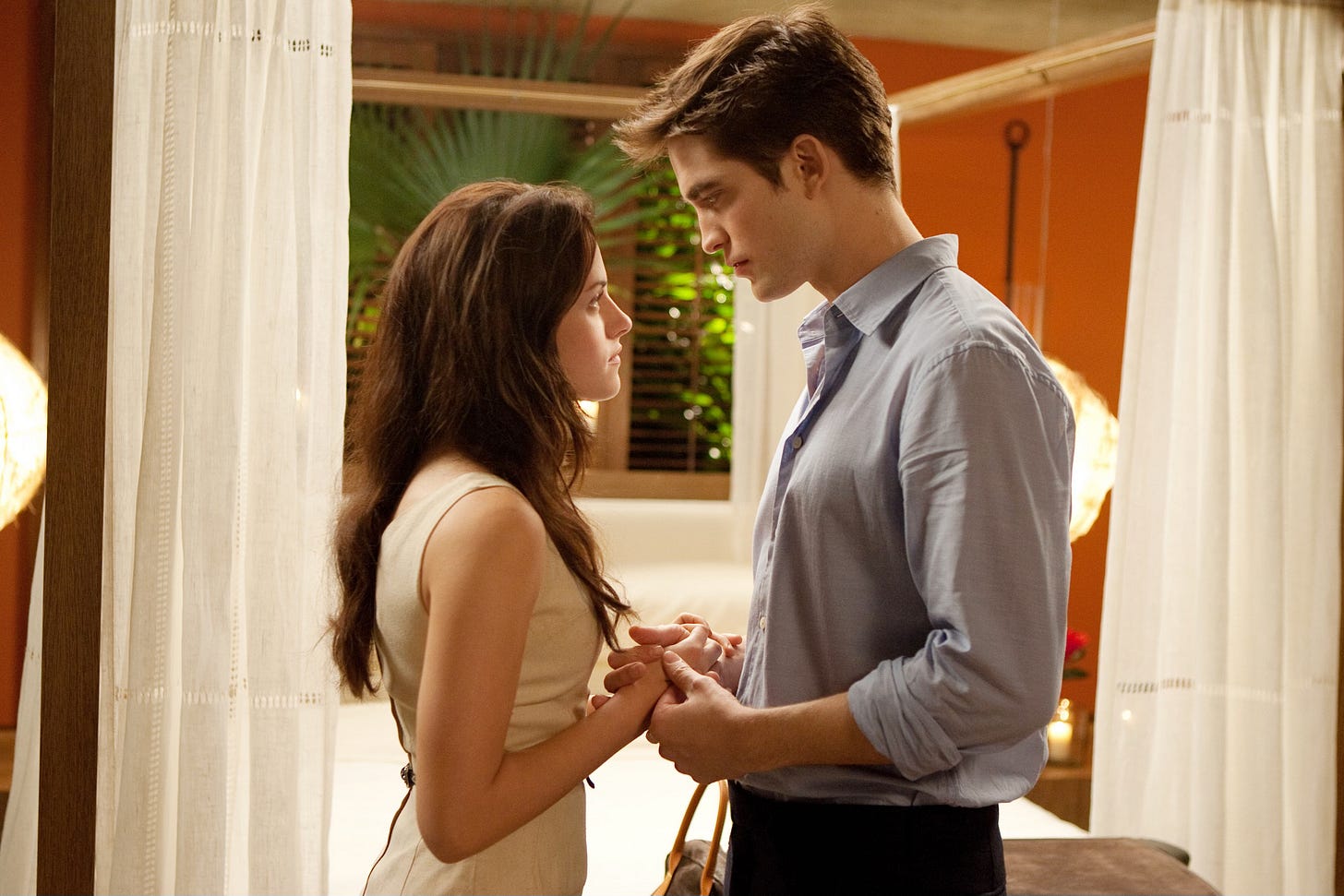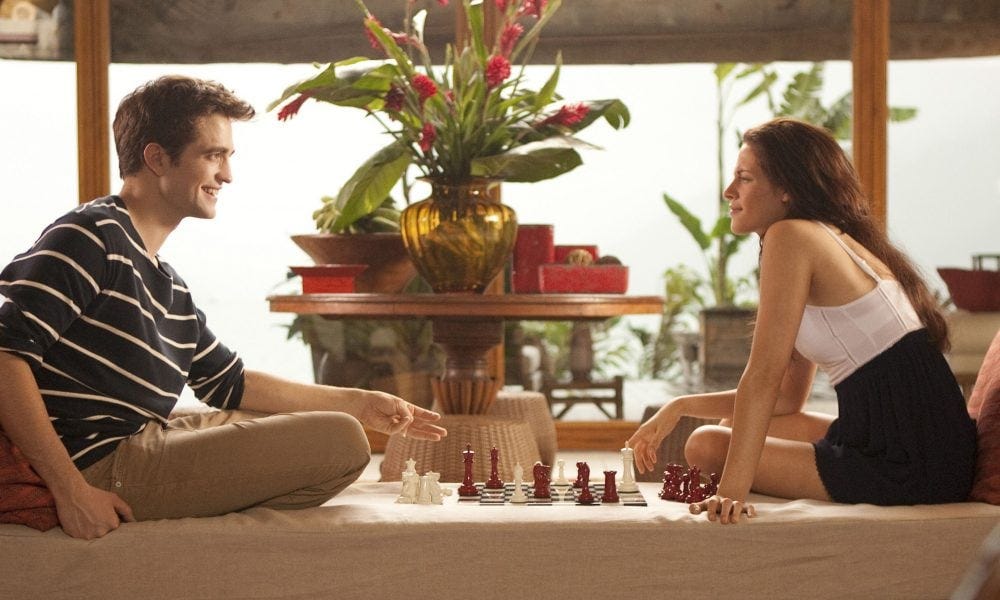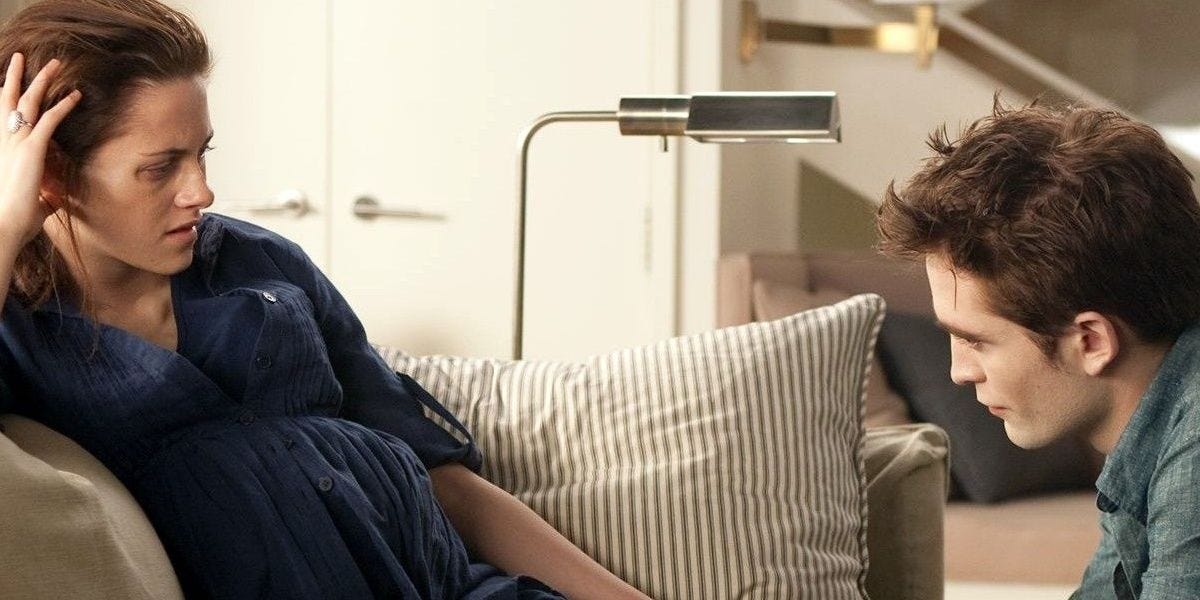The Twilight Saga: Breaking Dawn Part 1
Well, it’s taken a while with the end of the semester, but I’ve finally finished by breakdowns for Breaking Dawn Parts 1 & 2. Because these two movies are adapted from one book, they both present some challenges to analyzing and breaking them down. When books adaptations are split across two movies, there are generally two reasons: 1) the book is big and can’t fit into one movie and 2) the producers want to split the story into two movies to increase profits. Of course, there can be a little of each, and besides Twilight, we’ve seen this happen with series like The Hunger Games and Harry Potter. However, I will say that of those three, The Twilight Saga’s reasons for two final movies seems heavily balanced toward reason #2, the desire to increase profits. As we’ll see in both Part 1 and Part 2 we have acts and sequences with weaker goals, less conflict, and generally more “filling.” Having said that, all of the Twilight movies have had scenes and sequences that purposefully dwell on otherwise low-conflict moments, valuing the importance of the important moments in the relationship of Bella and Edward. So the “filling” in Parts 1 & 2 is partly justified in keeping with the tone of the earlier movies. So, lets’s take a look at Breaking Dawn Part 1!
As always, these breakdowns contain SPOILERS, and are only recommended if you've already seen the movie. You can check my introduction to these breakdowns, to get an overview of my process and philosophy.
Feel free to let me know what you think in the comments below!
The Basics
Director: Bill Condon
Writers: Melissa Rosenberg, Stephanie Meyer
Release Date: 2011
Runtime: 117 Minutes
IMDB: https://www.imdb.com/title/tt1324999
Movie Level Goals
Protagonist: Bella
External: Have her baby and survive
SUCCESS | FAILURE | MIXED
Internal/Relationship Goal: None
Three Observations
Observation #1: The Low Conflict Act 1
The padding of Breaking Dawn Parts One and Two starts immediately in the first act. The entire act is built around the wedding of Bella and Edward, with the inciting incident occurring around the 15 minute mark when they actually get married. The act has very little conflict centering almost entirely on the preparations for the wedding, the wedding itself, and the party afterwards. There is some minor conflict, often played for laughs, for example when Charlie sees the graduation cap artwork, and his general nervousness at seeing Bella. The only major conflict comes around the 25 minute mark when Bella leaves the party to go see Jacob who hasn't attended the wedding. At first, they are both happy to see each other. However, when Jacob realizes that Bella will be human when they go on their honeymoon, he has his usual Jacob meltdown, assuming that if Bella and Edward have sex, Bella won't survive. Having said that, there is a general precedent for the Twilight series to spend more time than typical on rites of passage (see observation number two). For example, the first twilight movie spends quite a bit of time in the final act on Bella and Edward's graduation, and the dance afterward.
Observation #2: Acts Built Around Rites of Passage
Despite Bella’s rebellious nature, the Twilight series as a whole tends to be conservative. I don't necessarily mean politically, but more in the sense that it values traditional rites of passage. This makes sense for a couple of reasons. First, of course, the author of the novels, Stephanie Meyer, is a member of the Church of Jesus Christ of Latter-Day Saints. Secondly, and more importantly, the movies (and novels) are primarily aimed at heterosexual teenage girls, who might be assumed to be looking forward to, an excited for, the various upcoming rights of passage that girls and young women participate in. As mentioned above, the first Twilight movie places strong emphasis on Bella's graduation from high school. Even more strikingly, Breaking Dawn Part One is built almost entirely around the expected rights of passage of a young woman. In fact, the structure is literally built around these moments. Act one centers entirely on Bella and Edward's marriage. Act two centers on their honeymoon, and Bella's loss of virginity (after their marriage of course, as insisted upon by Edward). Finally, act three focuses on Bella's pregnancy and the delivery of her child Renesmee.
Observation #3: The Final Sequence
As mentioned in Observation #1, the first act has a significant amount of padding to fill out the first 30 minutes of the movie with Bella and Edward's wedding. While the second act relies on a number of montages highlighting both the honeymoon, and Bella's almost humorous attempts to seduce Edward, it does have quite a bit more conflict than act one. Additionally, act three is also filled with conflict, as the child that Bella carries threatens to literally eat her alive from the inside. This creates lots of conflicts between Bella and Edward and Bella and Jacob, as well as creating new alliances, primarily between Bella and Rosalee, but also between Edward and Jacob. Of course, there is also the conflict between Bella and the baby, as Bella's health deteriorates over the course of her accelerated pregnancy. Act three climaxes with the birth of Renesmee, and with a typical structure around these rites of passage, it would seem natural that the movie would end shortly after her birth. However, of course, there is a major conflict that accompanies the birth of the child, namely that Bella seems to have died giving birth. Normally, this might be a cliffhanger on which the movie ends, leaving the audience wondering and having to wait until the start of the final movie in the series to find out the fate of Bella. Instead though, Breaking Dawn Part One adds a 15-minute sequence after the birth of Renesmee dealing with Bella's death. Events in the last 15 minutes include Edward trying to resuscitate Bella, Billy thinking Bella is dead, Jacob imprinting on Renesmee, the wolf clan calling off their death sentence of the Cullens, the hints that Bella may actually be alive, and then the final shot of the movie in which Bella opens her eyes, and we discover that she is indeed alive. It seems like much of this could have been winnowed down, or better yet included in the first act of Part Two. As we'll see though, in the breakdown of Part Two, there are reasons why the filmmakers seem to have decided to include these events in an extended ending in Part One. But you're going to have to wait for the final installment of the Twilight breakdowns to find out why.








good reading! I agree about the rites of passage being important in this film, the graduation, marriage and honeymoon then pregnancy. I suppose since I was raised conservatively (that this is the order in which a girl's life should go), and it doesn't seem that odd to me, but I can see how different this is compared to current cultural norms for teen girls. And I do appreciate this viewpoint being in the movie, as something to consider and potentially discuss.
The ending was just such a cliffhanger! Having not read the books and just watched the movies, it was one of the best cliffhanger endings to a movie I've ever seen! (could have done without all the honeymoon stuff though,) but I'm glad they made breaking dawn 2, because there was a lot of stuff to cover. look forward to seeing your analysis of the last film!